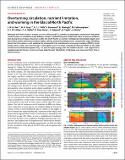Overturning circulation, nutrient limitation, and warming in the Glacial North Pacific
Abstract
Although the Pacific Ocean is a major reservoir of heat and CO2, and thus an important component of the global climate system, its circulation under different climatic conditions is poorly understood. Here, we present evidence that during the Last Glacial Maximum (LGM), the North Pacific was better ventilated at intermediate depths and had surface waters with lower nutrients, higher salinity, and warmer temperatures compared to today. Modeling shows that this pattern is well explained by enhanced Pacific meridional overturning circulation (PMOC), which brings warm, salty, and nutrient-poor subtropical waters to high latitudes. Enhanced PMOC at the LGM would have lowered atmospheric CO2—in part through synergy with the Southern Ocean—and supported an equable regional climate, which may have aided human habitability in Beringia, and migration from Asia to North America.
Citation
Rae , J W B , Gray , W R , Wills , R C J , Eisenman , I , Fitzhugh , B , Fotheringham , M , Littley , E , Rafter , P A , Rees-Owen , R L , Ridgwell , A , Taylor , B & Burke , A 2020 , ' Overturning circulation, nutrient limitation, and warming in the Glacial North Pacific ' , Science Advances , vol. 6 , no. 50 , eabd1654 . https://doi.org/10.1126/sciadv.abd1654
Publication
Science Advances
Status
Peer reviewed
ISSN
2375-2548Type
Journal article
Description
This work was funded by NERC grant NE/N011716/1 to J.W.B.R., a NERC studentship to B.T., and NSF grant OPP 1643445 to I.E. A.R. acknowledges support from NSF grant 1736771.Collections
Items in the St Andrews Research Repository are protected by copyright, with all rights reserved, unless otherwise indicated.

